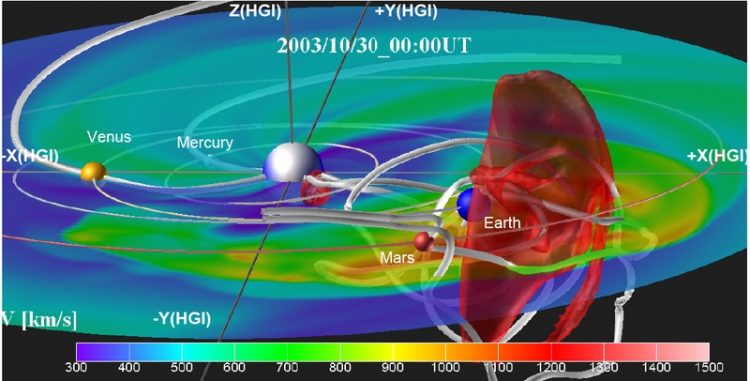New Coronal Mass Ejection Simulations Hold Promise for Future of Space Weather Forecasting

A coronal mass ejection (CME) event showing a representation of the flux rope anchored at the sun and the propagation of the magnetic flux rope through space toward Earth. The white shaded lines indicate the magnetic field lines. Red shade indicates high speed stream in the front of the CME. Copyright : Nagoya University
Researchers develop a successful and validated new model of coronal mass ejections to improve space weather forecasting.
Nagoya, Japan – Coronal mass ejections (CMEs) are massive expulsions of magnetic flux into space from the solar corona, the ionized atmosphere surrounding the sun.
Magnetic storms arising from CMEs pose radiation hazards that can damage satellites and that can negatively impact communications systems and electricity on Earth. Accurate predictions of such events are invaluable in space weather forecasting.
A new and robust simulation code for CME events was developed based on the realistic description of the mechanisms behind CME generation and their propagation through space. An article recently published in Space Weather presents their results from the method, which was successfully validated using observational data from a series of CME events reaching the Earth’s position around Halloween of 2003.
“Our model is able to simulate complex ‘flux ropes’, taking into account the mechanisms behind CME generation derived from real-time solar observations. With this model, we can simulate multiple CMEs propagating through space. A part of the magnetic flux of the original flux rope inside the CME directed southward was found to reach the Earth, and that can cause a magnetic storm,” explains lead author Daikou Shiota of the Nagoya University Institute of Space and Earth Environmental Research.
The new model represents a significant step in space weather research. “The inclusion of the flux rope mechanism helps us predict the amplitude of the magnetic field within a CME that reaches the Earth’s position, and accurately predicts its arrival time,” Shiota says.
A series of CMEs occurring in late-October 2003 released large flares of magnetic energy that reached the Earth several days later, causing radio blackouts and satellite communications failures. Data from these events were used to validate the approach taken in the new model.
“In our validation, we were able to predict the arrival of a huge magnetic flux capable of causing one of the largest magnetic storms in the last two decades,” says coauthor Ryuho Kataoka of the National Institute of Polar Research and the Department of Polar Science, SOKENDAI (Graduate University for Advanced Studies).
“Because our model does not simulate the solar coronal region, its computational speed is fast enough to operate under real-time forecasting conditions. This has various applications in ensemble space weather forecasting, radiation belt forecasting, and for further study of the effects of CME-generated solar winds on the larger magnetic structure of our solar system.” Shiota says.
This is a new generation of a well-developed complex flux rope within a CME model, and it provides a valuable step towards enhanced operational space weather forecasting. These findings will significantly contribute to accurately predicting magnetic fields in space and enhancing our understanding of the mechanisms behind CME events.
The article “Magnetohydrodynamic simulation of interplanetary propagation of multiple coronal mass ejections with internal magnetic flux rope (SUSANOO-CME)” was published in Space Weather, at doi:10.1002/2015SW001308
Journal information
Space Weather, at doi:10.1002/2015SW001308
Media Contact
All latest news from the category: Physics and Astronomy
This area deals with the fundamental laws and building blocks of nature and how they interact, the properties and the behavior of matter, and research into space and time and their structures.
innovations-report provides in-depth reports and articles on subjects such as astrophysics, laser technologies, nuclear, quantum, particle and solid-state physics, nanotechnologies, planetary research and findings (Mars, Venus) and developments related to the Hubble Telescope.
Newest articles

NASA: Mystery of life’s handedness deepens
The mystery of why life uses molecules with specific orientations has deepened with a NASA-funded discovery that RNA — a key molecule thought to have potentially held the instructions for…

What are the effects of historic lithium mining on water quality?
Study reveals low levels of common contaminants but high levels of other elements in waters associated with an abandoned lithium mine. Lithium ore and mining waste from a historic lithium…

Quantum-inspired design boosts efficiency of heat-to-electricity conversion
Rice engineers take unconventional route to improving thermophotovoltaic systems. Researchers at Rice University have found a new way to improve a key element of thermophotovoltaic (TPV) systems, which convert heat…



